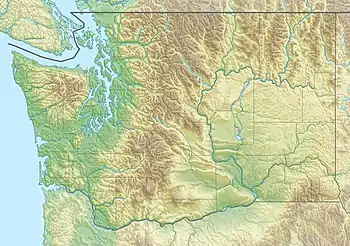| Eagle Point | |
|---|---|
 Eagle Point seen from the south | |
| Highest point | |
| Elevation | 6,247 ft (1,904 m)[1] |
| Prominence | 161 ft (49 m)[1] |
| Parent peak | Elk Mountain (6,773 ft)[2] |
| Isolation | 2.85 mi (4.59 km)[2] |
| Coordinates | 47°56′21″N 123°24′33″W / 47.939252°N 123.409067°W[1] |
| Geography | |
 Eagle Point Location of Eagle Point in Washington  Eagle Point Eagle Point (the United States) | |
| Location | Clallam County, Washington, US |
| Parent range | Olympic Mountains |
| Topo map | USGS Mount Angeles |
| Geology | |
| Age of rock | Eocene |
| Climbing | |
| Easiest route | Hiking class 2 |
Eagle Point is a 6,247 feet (1,904 m) summit in the Olympic Mountains and is located in Clallam County of Washington state.[3] It is set on Hurricane Ridge within Olympic National Park. It's situated midway between Steeple Rock and Obstruction Peak, 1.42 mi (2.29 km) to the southeast. Precipitation runoff drains into tributaries of the Elwha River and Morse Creek, thence into the Strait of Juan de Fuca.
Climate
Set in the north-central portion of the Olympic Mountains, Eagle Point is located in the marine west coast climate zone of western North America. Most weather fronts originate in the Pacific Ocean, and travel northeast toward the Olympic Mountains. As fronts approach, they are forced upward by the peaks of the Olympic Range, causing them to drop their moisture in the form of rain or snowfall (Orographic lift). As a result, the Olympics experience high precipitation, especially during the winter months in the form of snowfall. During winter months, weather is usually cloudy, but, due to high pressure systems over the Pacific Ocean that intensify during summer months, there is often little or no cloud cover during the summer. Because of maritime influence, snow tends to be wet and heavy, resulting in high avalanche danger.
Waterhole is a weather station on the eastern slope below Eagle Point.
| Climate data for Waterhole, Washington, 2003–2022 normals: 5010ft (1527m) | |||||||||||||
|---|---|---|---|---|---|---|---|---|---|---|---|---|---|
| Month | Jan | Feb | Mar | Apr | May | Jun | Jul | Aug | Sep | Oct | Nov | Dec | Year |
| Mean daily maximum °F (°C) | 34.8 (1.6) |
33.9 (1.1) |
36.4 (2.4) |
41.0 (5.0) |
48.6 (9.2) |
54.1 (12.3) |
61.8 (16.6) |
62.3 (16.8) |
56.0 (13.3) |
45.9 (7.7) |
36.3 (2.4) |
31.6 (−0.2) |
45.2 (7.4) |
| Daily mean °F (°C) | 30.2 (−1.0) |
28.1 (−2.2) |
30.0 (−1.1) |
33.5 (0.8) |
40.6 (4.8) |
45.9 (7.7) |
52.9 (11.6) |
53.5 (11.9) |
48.1 (8.9) |
39.9 (4.4) |
31.5 (−0.3) |
27.1 (−2.7) |
38.4 (3.6) |
| Mean daily minimum °F (°C) | 25.5 (−3.6) |
22.4 (−5.3) |
23.5 (−4.7) |
26.0 (−3.3) |
32.6 (0.3) |
37.7 (3.2) |
43.9 (6.6) |
44.7 (7.1) |
40.1 (4.5) |
33.8 (1.0) |
26.7 (−2.9) |
22.7 (−5.2) |
31.6 (−0.2) |
| Average precipitation inches (mm) | 12.03 (306) |
7.38 (187) |
8.60 (218) |
4.54 (115) |
3.02 (77) |
1.59 (40) |
0.60 (15) |
1.19 (30) |
2.18 (55) |
6.19 (157) |
12.02 (305) |
12.11 (308) |
71.45 (1,813) |
| Source 1: XMACIS2[4] | |||||||||||||
| Source 2: NOAA (Precipitation)[5] | |||||||||||||
Geology
The Olympic Mountains are composed of obducted clastic wedge material and oceanic crust, primarily Eocene sandstone, turbidite, and basaltic oceanic crust.[6] The mountains were sculpted during the Pleistocene era by erosion and glaciers advancing and retreating multiple times.
See also
Gallery
References
- 1 2 3 "Eagle Point". Peakbagger.com.
- 1 2 "Eagle Point - 6,247' WA". listsofjohn.com. Retrieved 2021-12-30.
- ↑ "Eagle Point". Geographic Names Information System. United States Geological Survey, United States Department of the Interior. Retrieved 2018-08-07.
- ↑ "xmACIS2". National Oceanic and Atmospheric Administration. Retrieved September 24, 2023.
- ↑ "Waterhole, Washington 1991-2020 Monthly Normals". Retrieved September 26, 2023.
- ↑ Alt, D.D.; Hyndman, D.W. (1984). Roadside Geology of Washington. pp. 249–259. ISBN 0-87842-160-2.
External links
- Weather forecast: Eagle Point
- "Olympic National Park". National Park Service.

